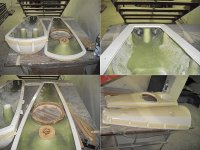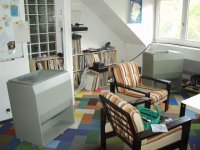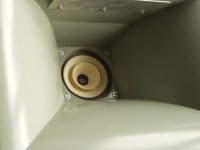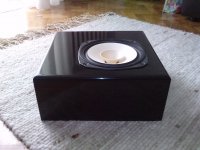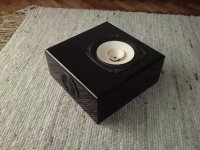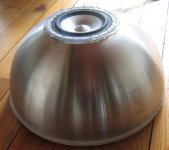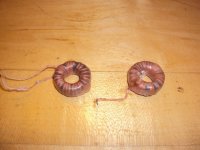A corner could be used to produce phantom images and then one cabinet could be enough to get stereo. I will think about how to arange speakers to do that.
In fact the baby MPLs are small enough to try that.
In fact the baby MPLs are small enough to try that.
Original (1958-1972) Lowther Audio Vector can be regarded as an early example of a flooder 🙂
Lowther USA Bass Horn Speaker Cabinets.
pictures attached are of DIY homemade Audiovector
Lowther USA Bass Horn Speaker Cabinets.
pictures attached are of DIY homemade Audiovector
Attachments
graaf>
I've found that website too and there is written that:
"Audiovector was designed by British sloping ceilings, with the expectation that the sound of the horn, the striker up, will affect the listener. Just a Guido, the system is on the attic floor with the ceiling. But now it is perpendicular to the slope. According to Oleg, earlier, when the system was placed parallel to the slope of the ceiling, it sounded better.
I've found that website too and there is written that:
"Audiovector was designed by British sloping ceilings, with the expectation that the sound of the horn, the striker up, will affect the listener. Just a Guido, the system is on the attic floor with the ceiling. But now it is perpendicular to the slope. According to Oleg, earlier, when the system was placed parallel to the slope of the ceiling, it sounded better.
And:
"The scene is passed very well, but a bit strange - a voice somewhere near the ceiling."
P.S. I was using translator from russian to english.
"The scene is passed very well, but a bit strange - a voice somewhere near the ceiling."
P.S. I was using translator from russian to english.
"According to Oleg, earlier, when the system was placed parallel to the slope of the ceiling, it sounded better."
And:
"The scene is passed very well, but a bit strange - a voice somewhere near the ceiling."
yeah, I have noticed that, perhaps such a waveguide is not the best idea in case of flooding?
best!
graaf
Try the folowing . Use "normal" speakers and put them more and more apart. If you put them more then 3m apart something strange happens. The voice comes from high up !
It is called the elevation effect and was researched by Blauert. Give your speakers +3dB of gain @ ca.7kHz and the same happens even when they are closer then 3m.
Graaf, you totally underestimate the problem.
It is called the elevation effect and was researched by Blauert. Give your speakers +3dB of gain @ ca.7kHz and the same happens even when they are closer then 3m.
Graaf, you totally underestimate the problem.
Try the folowing . Use "normal" speakers and put them more and more apart. If you put them more then 3m apart something strange happens. The voice comes from high up !
It is called the elevation effect and was researched by Blauert. Give your speakers +3dB of gain @ ca.7kHz and the same happens even when they are closer then 3m.
Graaf, you totally underestimate the problem.
but it's the problem with some speakers/speaker placements and not with the flooder as such, isn't it?
I have heard about those effects which come from head and pinnae transfer functions that determine sound source localisation in vertical plane
so perhaps those Lowthers in an AudioVector waveguide have those bumps that can cause shifts in vertical localization?
I have never experience near ceiling voice localization with my flooder, in fact the medium elevation of the soundstage was always at the ear height, the sound was never localized near the floor (that is actual speaker level) nor near the ceiling
I've been researching this question and so far I cannot find any information about effects of vertical reflections coming from above the actual sound source on its localization
my hypothesis is that unlike floor reflection, which is very important, ceiling reflection doesn't carry any usable psychoacoustic information on sound source localization - it is not processed by the brain as a localization cue
and this is because - as el`Ol put it - "our monkey ancestors had no ceiling reflections" 😉
what do You think?
best!
graaf
Image diferentiation in the vertical plane is much worse then in the horitontal plane.
We simply do not have a third ear high up. Still the brain-ear combo can diferentiate somewhat vertically. It has to do with the HRTF and you have mentioned pinnea transfer function. A standart volume about sound lokalisation is from Blauert. I have the unfortunate expensive new issue with some new information.
One problem is reflexion from the outer ear itself and there we run into the problem that all our ears have a slightly different shape, but this toutches only the surface.
3 dimesional imaging is fascinating and when a good spaeker can pull the trick the effect it has on listeners never fails to impress.
One little anecdote : Many years ago i was at a Flatt Earth Linn dealer. He had invited me to listen to what he thought the best system in the world. I heard Paolo Conte singing 1m under the speakers exactly in the middle of the wall mounted speakers at floor level ! Talk about vertical diferentiation in the down dimension.
By the way, do you have a photo of your flodder, so that i get a better idea.
We simply do not have a third ear high up. Still the brain-ear combo can diferentiate somewhat vertically. It has to do with the HRTF and you have mentioned pinnea transfer function. A standart volume about sound lokalisation is from Blauert. I have the unfortunate expensive new issue with some new information.
One problem is reflexion from the outer ear itself and there we run into the problem that all our ears have a slightly different shape, but this toutches only the surface.
3 dimesional imaging is fascinating and when a good spaeker can pull the trick the effect it has on listeners never fails to impress.
One little anecdote : Many years ago i was at a Flatt Earth Linn dealer. He had invited me to listen to what he thought the best system in the world. I heard Paolo Conte singing 1m under the speakers exactly in the middle of the wall mounted speakers at floor level ! Talk about vertical diferentiation in the down dimension.
By the way, do you have a photo of your flodder, so that i get a better idea.
By the way, do you have a photo of your flodder, so that i get a better idea.
my main system is now disassembled after moving into a new apartment and the original flooders with cyanoacrylate modified FE206E had been destroyed even earlier by a small kitten, you can imagine what he did with them 😉
now I listen to music mainly casually with flooded KEF UniQ bookshelf speaker
the flooder is now out of use because of 2-year boy in the house, as it is known that such a boy is even more destructive being than small kitten 😉
the UniQ is relatively safe as it has grille and looks sufficiently uninteresting 😉
so I had just put new, yet untreated FE206E into flooder cabinet to take the photos below
now I listen to just one UniQ in mono, it is positioned near the wall (the three distances to boundaries according to golden section)
below is also schematic of my living room
the slim rectangle up means windows and similar one down means open passage to another room
on the right: two sofas and a coffee table, the circle in the corner means big plant
on the left: a table with chairs, and a cupboard
up in the center a chest of drawers with TV on it
the flooded KEF (with bass reflex port blocked) is near right corner up and my armchair is near left corner down
there are two carpets - one below the coffee table and the other one below the table
the room is circa 570x360 cm, 300 cm height
the sound is totally detached from the speaker, the sound scene is 3D, it takes up a kind of spherical form (the size of it depends on SPL) and in it the specific sound sources are separated from each other, there is strong sensation of virtual space, sound sources are surrounded by ambient, there is depth and planes within it
perceived acoustics depends on the recording - jazz club recording sounds like jazz club and church recording like church and so on
what is lacking is horizontal stereophonic left-right spread of the soundstage, there is a spread - vertical and also horizontal - but unlike stereophonic
best regards,
graaf
Attachments
Last edited:
All this is starting to be threadjacking, but I can't resist bringing some updates for my Carlsson project.
For those who don't know:
CarlssonPlanet.com • Everything about the Carlsson loudspeakers
By el_ol at 2010-01-29
Everything had been perfect, just quite layed-back bass, because my assumption that I need no bafflestep compensation due to the wall placement appeared to be too optimistic. The sound quality of my Panasonic SA-XR30 goes down the toilet when I turn up the bass, so I bought the SA-XR55, which is biamping-capable. There turning up the bass proved to be non-detremental to the sound, in contrast to the biamping-balance, and I was happy with that for a week or so. But now my sense of depth is vanishing. The instruments/singers have a position in the stereo panorama, but distance is indetermined, probably hard to imagine for someone who hasn't heard it. When I concentrate on a single instrument it plays about one meter in front of my nose, and when i stop concentrating the distance is indetermined again. Removing the bass-boost only slightly improves the situation. I couldn't detect an error in the system with my measurements.
Doing too much psychoacoustics seems to be like walking on thin ice.
I had "pure" flooders, too, just with the drivers on ear-height. I don't want to go back because I don't like paper in the top octave, and I have sold my Ciare HX201 drivers anyway, so currently I really don't know what to do.
For those who don't know:
CarlssonPlanet.com • Everything about the Carlsson loudspeakers
An externally hosted image should be here but it was not working when we last tested it.
By el_ol at 2010-01-29
Everything had been perfect, just quite layed-back bass, because my assumption that I need no bafflestep compensation due to the wall placement appeared to be too optimistic. The sound quality of my Panasonic SA-XR30 goes down the toilet when I turn up the bass, so I bought the SA-XR55, which is biamping-capable. There turning up the bass proved to be non-detremental to the sound, in contrast to the biamping-balance, and I was happy with that for a week or so. But now my sense of depth is vanishing. The instruments/singers have a position in the stereo panorama, but distance is indetermined, probably hard to imagine for someone who hasn't heard it. When I concentrate on a single instrument it plays about one meter in front of my nose, and when i stop concentrating the distance is indetermined again. Removing the bass-boost only slightly improves the situation. I couldn't detect an error in the system with my measurements.
Doing too much psychoacoustics seems to be like walking on thin ice.
I had "pure" flooders, too, just with the drivers on ear-height. I don't want to go back because I don't like paper in the top octave, and I have sold my Ciare HX201 drivers anyway, so currently I really don't know what to do.
Well, i have no problem when you post your solutions here. i got very busy with other projects ( need some income ) so i will not post much in the next two weeks.
Your contributions keeps this thread alive and interesting, so please send me anything that could be interesting.
Both of your projects look interesting and innovative.
Your contributions keeps this thread alive and interesting, so please send me anything that could be interesting.
Both of your projects look interesting and innovative.
HF coils
Today i made some coils for the Ribbon Horntweeters in my big MPL baffle. So far i am using wax dipped air cores and everything is fine. This time i try coils that are made like HF coils. I used a ferite ring and silk isolated litz wire. I wound by hand and ca.30 windings proved to be enough for the value i need. The cable is not very thick but because it is only less then half a meter long the DC Ohmic value ended up under 0.1 Ohm. I dipped the coils 3 times in wax to stabilise them mechanically. I do not know if the ferrite ring is any good for Audio. I had it lying around for another purpose. I had tryed toroids for bass work in speakers successfully but i never tryed a construction like that in the treble. Tomorrow when i build it in i know more.
Today i made some coils for the Ribbon Horntweeters in my big MPL baffle. So far i am using wax dipped air cores and everything is fine. This time i try coils that are made like HF coils. I used a ferite ring and silk isolated litz wire. I wound by hand and ca.30 windings proved to be enough for the value i need. The cable is not very thick but because it is only less then half a meter long the DC Ohmic value ended up under 0.1 Ohm. I dipped the coils 3 times in wax to stabilise them mechanically. I do not know if the ferrite ring is any good for Audio. I had it lying around for another purpose. I had tryed toroids for bass work in speakers successfully but i never tryed a construction like that in the treble. Tomorrow when i build it in i know more.
Attachments
Today i tryed another little wideband driver in the Baby MPL cabinet. It is from Vifa and does not cost much. It has a coated paper membrane in a plastic basket and has a copper ring in the magnet system. The membrane is cut at 5 sides so it is not without sofistication. I call this version Micro MPL and it is one of the most simple and cheep speakers i ever build. It has a lot of the typical wideband magic and goes loud enough for late night listening or computer work. Do not expect the fast transients of the Fountek metal driver and it is no match in sheer naturalness to the Scan Speak wideband driver. Still it sounds very coherent over a broad range from 150Hz to 12kHz.
Soundstaging is wide, deep and focussed with surprising height. As always, i do not use any kind of equalisation to keep the signal path clean and simple. I did not find the time to measure but the spec sheet looks ok. I am using now always the same arangement. My Preamp has two active outputs that go to the main amplifier and the subwoofer. In line with the main amplifiers is a simple 6dB passive filter with silver mica caps. I am using my big X Dipole woofer, so this is a bit unrealistic but i will soon try an M Dipole i build with two 30cm Peerless woofers that are affordable. Other active woofers should work fine too and there is a huge choice on the market for every taste and pocket so i have no desire to add another conventional subwoofer to the game. I will post the spec sheet ( it is in German, sorry ), some photos and the electronic setup.
Soundstaging is wide, deep and focussed with surprising height. As always, i do not use any kind of equalisation to keep the signal path clean and simple. I did not find the time to measure but the spec sheet looks ok. I am using now always the same arangement. My Preamp has two active outputs that go to the main amplifier and the subwoofer. In line with the main amplifiers is a simple 6dB passive filter with silver mica caps. I am using my big X Dipole woofer, so this is a bit unrealistic but i will soon try an M Dipole i build with two 30cm Peerless woofers that are affordable. Other active woofers should work fine too and there is a huge choice on the market for every taste and pocket so i have no desire to add another conventional subwoofer to the game. I will post the spec sheet ( it is in German, sorry ), some photos and the electronic setup.
